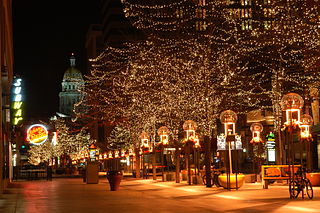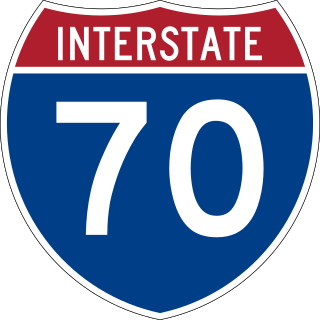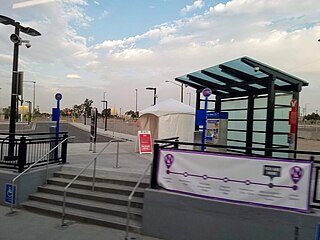
Globeville is a neighborhood of Denver, Colorado. Globeville is located in the area traditionally called North Denver. [1]

Globeville is a neighborhood of Denver, Colorado. Globeville is located in the area traditionally called North Denver. [1]
According to a document titled, "Globeville Neighborhood Assessment," prepared by the Denver Department of Planning and Community Development in 2008, "Globeville is located in north Denver and is bounded by the South Platte River on the east and south, Inca Street on the west, and the City limits (mostly 52nd Avenue) on the north. The neighborhood is identified by the 2000 U.S. Census as Census Tract 15. Interstates 25 and 70 bisect the neighborhood vertically and horizontally, respectively." [2]
This article contains too many or overly lengthy quotations .(February 2012) |
Planned in 1889, incorporated in 1891, and settled primarily by European immigrants during the late nineteenth century, the town of Globeville grew up around the Globe Smelting and Refining Company and a meat packing plant that had been established during this same period and benefitted from the proximity of a nearby railroad line. Members of the community's early population included children and adults from Austria, Croatia, Germany, Poland, and Russia, among others. In 1902, the city and county of Denver annexed Globeville, making it one of the city's neighborhoods.
Within a century, the area had become so contaminated by the operations of that smelting plant that environmental and social justice activist Lorraine Granado, a longtime resident of Denver's neighboring Elyria-Swansea community, founded the Cross Community Coalition to mobilize the residents of Globeville and Elyria-Swansea to try to improve their standard of living. After opening a Family Resource Center at the corner of Josephine and 46th streets, Granado became the group's executive director and began working with other members of the community to create after-school tutoring, citizenship, English language, GED preparation, and job training programs, as well as home improvement and small business management classes. [3] [4] [5]
Coalition members also worked to mitigate the negative impact of the nearby I-70 freeway and factories by forming Neighbors for a Toxic-Free Community. Pressuring city leaders and corporate executives to remediate the pollution caused by area factories, they stopped the city from erecting a medical waste incinerator in 1991. They then achieved a class-action settlement with ASARCO three years later in which they forced the company to undo the pollution caused by its smelting plant. In addition to paying $38 million to clean up soil in Globeville that had been contaminated with arsenic, trioxide, cadmium, and lead, ASARCO also provided $24 million to residents to compensate them for their decreased property values. [6] [7] [8] [9] [10]
According to the 2008 neighborhood assessment,
Even in its early years, Globeville was isolated from the rest of the city. The railroads and South Platte River served as physical barriers. There was only one streetcar stop, located just outside Globeville, and the automobile was not yet a viable transportation option. With such limited access, the majority of people who worked within Globeville also lived in the neighborhood. The diverse immigrant populations thrived as churches and social organizations grew up around the various nationalities.
Globeville's isolation was further impacted in the mid-20th century when two interstates were constructed that bisected the neighborhood. Construction of Interstate 25 began in 1948 and was completed in 1958. It runs north and south through the middle of the Globeville neighborhood.
Interstate 70 was subsequently completed in 1964. Interstate 70 divided the eastern residential area of Globeville, and its construction resulted in the loss of 30 homes.
Globeville's history as a home for immigrants has continued into the present. Over the past few decades, an increasing Latino or Hispanic population has moved into the Globeville neighborhood.
The current mix of multi-generational residents and new immigrants continues the rich diversity that the Globeville neighborhood experienced in the past.
Today, portions of Globeville continue to be physically isolated from the rest of Denver by the freeways, railroad lines, and South Platte River. However, the freeways and railroads have also continued to make Globeville an attractive location for business and industry. Several large operations and employers are located within the neighborhood and nearby, including the Denver Coliseum and Stock Show complex, the Bannock Street furniture business district, and the Pepsi bottling plant. [11]
The average price per square foot of a home in Globeville in May, 2017 was $420.15. [12]
The racial makeup of Globeville is 10.57% white (4.98% white alone-non Hispanic), 2.11% African American, 0.50% Asian, 0.44% Native American. Hispanic or Latino of any race is 91.95% of the population. [13]
The Globeville neighborhood poverty rate is 23.15% of the population, well above the Denver and national averages. Globeville has one of the highest crime rates in all of Denver, with a rate of 288 incidents per 1,000 people. [14]
Globeville contains several landmarks and structures that are well known in the Denver area. One of these is the Mousetrap, which is the large freeway interchange where Interstate 25 intersects with Interstate 70 in the neighborhood. Another is Saint Joseph's Polish Roman Catholic Church, located at 517 East 46th Avenue, in the neighborhood. Also, the South Platte River serves as the neighborhood's eastern boundary. A park called Globeville Landing Park is on the east side of the river, technically outside the neighborhood. The Colorado Front Range Trail runs through Globeville along the west bank of the South Platte River and is used here mainly as a bike path. Another significant landmark in Globeville, and a favorite of the children, is Argo park. It is located in the heart of Globeville.

Denver is a consolidated city and county, the capital, and most populous city of the U.S. state of Colorado. It is located in the western United States, in the South Platte River Valley on the western edge of the High Plains east of the Front Range of the Rocky Mountains. With a population of 715,522 as of the 2020 census, a 19.22% increase since 2010, Denver is the 19th most populous city in the United States and the fifth most populous state capital. It is the principal city of the Denver–Aurora–Lakewood metropolitan statistical area, with almost 3 million people the most populous metropolitan area in Colorado. Denver is the economic and cultural center of the broader Front Range Urban Corridor, home to more than 5 million people.

ASARCO is a mining, smelting, and refining company based in Tucson, Arizona, which mines and processes primarily copper. The company has been a subsidiary of Grupo México since 1999.

Auraria was a gold mining camp established in 1858 in the Kansas Territory of the United States. Today it survives in its original location as a neighborhood of Denver, Colorado, immediately south of the confluence of Cherry Creek and the South Platte River.

Interstate 76 (I-76) is an east–west Interstate Highway in the Western United States that runs from I-70 in Arvada, Colorado – near Denver – to an interchange with I-80 near Big Springs, Nebraska. The highway measures 187.29 miles (301.41 km) long, mostly situated in Colorado but approximately three miles (4.8 km) of which is in Nebraska. Along the route, the highway runs concurrent with US 6, US 85 in the Denver metropolitan area, and US 34 from Wiggins to Fort Morgan. It has no auxiliary Interstates, but it has two business routes that are located in northeastern Colorado. This route is not connected with the other I-76 that spans from Ohio to New Jersey.

Clear Creek is a tributary of the South Platte River, approximately 66 miles (106 km) long, in north central Colorado in the United States. The creek flows through Clear Creek Canyon in the Rocky Mountains directly west of Denver, descending through a long gorge to emerge at the town of Golden, finally ending in the Colorado Eastern Plains where it joins the South Platte. Clear Creek is unusual in that it is a stream named "creek" fed by a stream named "river"; typically "rivers" are fed by "creeks", and are larger bodies of water, although the nomenclature is ambiguous and there is no clear system. Fall River empties into Clear Creek along I-70 west of Idaho Springs, Colorado.
Grupo México is a Mexican conglomerate that operates through the following divisions: Mining, Transportation, Infrastructure and Fundacion Grupo Mexico.

State Highway 470 is a freeway located in the southwestern portion of the Denver Metro Area. It is also the southwestern portion of the Denver Metro area's beltway. SH 470 begins at US 6 in Golden and heads south interchanging Interstate 70 and then US 285 outside Morrison. After leaving Morrison, it then heads east passing by Littleton and through Highlands Ranch before interchanging Interstate 25 in Lone Tree, where the freeway continues as a tollway and where the state highway designation ends.

Five Points is one of the oldest neighborhoods in Denver, Colorado. It is now one of the fastest growing in terms of both redevelopment and population. Much of this growth is taking place in the River North Arts District, or "RiNo", which is often considered by locals a neighborhood of its own; although it is officially within the Five Points neighborhood in addition to parts of neighboring Globeville and Elyria-Swansea.

Jefferson Park is a neighborhood and public park that overlooks Downtown Denver, Colorado from its perch across Interstate 25 (I-25). It is located in the area that is called North Denver. Views east from Jefferson Park take in Elitch Gardens Theme Park, The Children's Museum, Denver's Downtown Aquarium, Pepsi Center, the REI flagship store and other attractions in Downtown's Central Platte Valley. Downtown Denver and the Central Platte Valley are quickly accessed from Jefferson Park, using the 23rd Avenue overpass on I-25 and Water Street. In addition, the Light Rail C-Line is located by Empower Field at Mile High in the southern part of the neighborhood.

Baker is a neighborhood in Denver, Colorado, United States.

Interstate 70 (I-70) is a transcontinental Interstate Highway in the United States, stretching from Cove Fort, Utah, to Baltimore, Maryland. In Colorado, the highway traverses an east–west route across the center of the state. In western Colorado, the highway connects the metropolitan areas of Grand Junction and Denver via a route through the Rocky Mountains. In eastern Colorado, the highway crosses the Great Plains, connecting Denver with metropolitan areas in Kansas and Missouri. Bicycles and other non-motorized vehicles, normally prohibited on Interstate Highways, are allowed on those stretches of I-70 in the Rockies where no other through route exists.

Sun Valley is a neighborhood in central Denver, Colorado, bordered by I-25 on the east, Federal Blvd. on the west, 6th Avenue on the south and 20th Ave. on the north. It is located in the area known as West Denver.

Elyria-Swansea is a neighborhood of Denver, Colorado. It is located in East Denver, on the northeast side of the city. In 2007, the neighborhood had 7,218 residents and 1,787 households. The racial makeup of the neighborhood in 2000 was, 9.9% non-Hispanic white, 5.31% African American, 83.02% Hispanic or Latino, 0.7% Native American, and 0.31% Asian.

Valverde is a neighborhood of Denver, Colorado. It is in the area known as West Denver or the "West Side". According to the Piton Foundation, in 2007, the population of the neighborhood was 4,093, and there were 1,276 housing units. Valverde home values are expected to grow substantially, due to the recent population growth in the Denver metro area. The commute to downtown Denver from the Valverde neighborhood is less than 5 minutes since the completion of 6th avenue, which no longer merges with I-25.
The North East Side (Denver), is a region/area located in both Denver County and Adams County. The neighborhoods located within Denver's north east side are Elyria-Swansea, Commerce City, and Derby. As of the 2007 Denver Piton Foundation and the United States Census Bureau, the region/area had a total population of 53,541 people.

48th & Brighton / National Western Center station is a station on the N Line of the Denver RTD commuter rail system in Denver, Colorado. It is the first station northbound from Union Station and is located on the edge of the Elyria-Swansea neighborhood. The station opened on September 21, 2020.

Union Station North, formerly known as Prospect, is a neighborhood within the city limits of Denver, Colorado. Previously dominated by industrial buildings, waste, railroad tracks and considered an area of the city to be avoided, today it has been rehabilitated into multi-story residential buildings, restaurants, amenities, easy access to downtown Denver, and is a short walk to the South Platte River Trail, which runs along its northern boundary.
Lorraine Granado was an American environmental, peace and social justice activist and organizer who was the founder and executive director of the Cross Community Coalition in Denver, Colorado, the co-founder of the Colorado People's Environmental and Economic Network, the co-founder of Neighbors for a Toxic-Free Community in Denver, and the co-director of the Rocky Flats Disarmament and Human Needs Project.